Cap-Haïtien
Cap-Haïtien (French: [kap a.i.sjɛ̃]; Haitian Creole: Kap Ayisyen; English: Haitian Cape), often referred to as Le Cap or Au Cap, is a commune of about 190,000 people on the north coast of Haiti and capital of the department of Nord. Previously named Cap‑Français (initially Cap-François)[4] and Cap‑Henri, it was historically nicknamed the Paris of the Antilles, because of its wealth and sophistication, expressed through its architecture and artistic life.[5][6][7][8] It was an important city during the colonial period, serving as the capital of the French Colony of Saint-Domingue from the city's formal foundation in 1711 until 1770 when the capital was moved to Port-au-Prince. After the Haitian Revolution, it became the capital of the Kingdom of Northern Haiti under King Henri Christophe until 1820.
Cap-Haïtien Kap Ayisyen | |
|---|---|
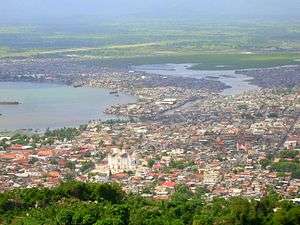 | |
| Nickname(s): Le Paris des Antilles The Paris of the Antilles | |
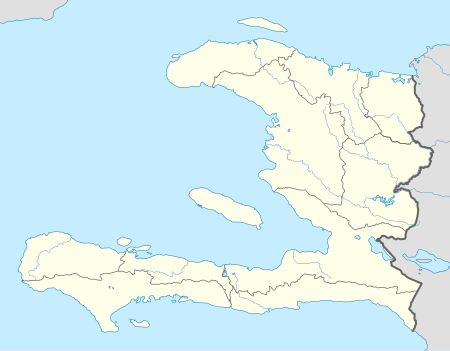 Cap-Haïtien Location in Haiti | |
| Coordinates: 19°45′36″N 72°12′00″W | |
| Country | Haiti |
| Department | Nord |
| Arrondissement | Cap-Haïtien |
| Founded | 1670 |
| Government | |
| • Mayor | Jean Renaud |
| Area | |
| • Total | 53.5 km2 (20.7 sq mi) |
| Elevation | 0 m (0 ft) |
| Population (March, 2015)[1] | |
| • Total | 274,404 |
| • Density | 5,129/km2 (13,280/sq mi) |
| Demonym(s) | Capois(e) |
| Time zone | UTC-5 (Eastern) |
| • Summer (DST) | UTC-4 (Eastern) |
| Sister cities[2] |
|---|
|
Cap-Haïtien's long history of independent thought was formed in part by its relative distance from Port-au-Prince, the barrier of mountains between it and the southern part of the country, and a history of large African populations. These contributed to making it a legendary incubator of independent movements since slavery times. For instance, from February 5–29, 2004, the city was taken over by militants who opposed the rule of the Haïtian president Jean-Bertrand Aristide. They eventually created enough political pressure to force him out of office and the country.
Cap-Haïtien is near the historic Haitian town of Milot, which lies 12 miles (19 km) to the southwest along a gravel road. Milot was Haiti's first capital under the self-proclaimed King Henri Christophe, who ascended to power in 1807, three years after Haiti had gained independence from France. He renamed Cap‑Français as Cap‑Henri. Milot is the site of his Sans-Souci Palace, wrecked by the 1842 earthquake. The Citadelle Laferrière, a massive stone fortress bristling with cannons, atop a nearby mountain is 5 miles (8.0 km) away. On clear days, its silhouette is visible from Cap‑Haïtien.
The small Hugo Chávez International Airport (formerly Cap-Haïtien International Airport), located on the southeast edge of the city, is served by several small domestic airlines. It has been patrolled by Chilean UN troops from the "O'Higgins Base" since the 2010 earthquake. The airport is currently being expanded. Several hundred UN personnel, including nearby units from Nepal and Uruguay, are assigned to the city as part of the ongoing United Nations Stabilization Mission in Haiti (MINUSTAH).
History and character
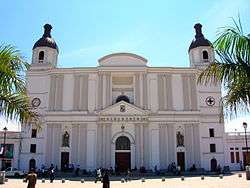
The island was occupied for thousands of years by cultures of indigenous peoples, who had migrated from present-day Central and South America. In the 16th century, Spanish explorers in the Caribbean began to colonize the island. They adopted the native name, Guárico for this area that is today known as "Cap‑Haïtien".[9] Due to the introduction of new infectious diseases, as well as poor treatment, the indigenous peoples population rapidly declined.
On the nearby coast Columbus founded his first community in the New World, the short-lived La Navidad. In 1975, researchers found near Cap‑Haïtien another of the first Spanish towns of Hispaniola: Puerto Real was founded in 1503. It was abandoned in 1578, and its ruins were not discovered until late in the twentieth century.[10]

The French took over half of the island of Hispaniola from the Spanish in the early eighteenth century. They established large sugar cane plantations on the northern plains and imported tens of thousands of African slaves to work them. Cap‑Français became an important port city of the French colonial period and the colony's main commercial centre.[5] It served as the capital of the French colony of Saint-Domingue from the city's formal founding in 1711 until 1770, when the capital was moved to Port-au-Prince on the west coast of the island. After the slave revolution, this was the first capital of the Kingdom of Northern Haiti under King Henri Christophe, when the nation was split apart.
The central area of the city is between the Bay of Cap‑Haïtien to the east and nearby mountainsides to the west; these are increasingly dominated by flimsy urban slums. The streets are generally narrow and arranged in grids. As a legacy of the United States' occupation of Haiti from 1915 to 1934, Cap‑Haïtien's north-south streets were renamed as single letters (beginning with Rue A, a major avenue) and going to "Q", and its east-west streets with numbers from 1 to 26; the system is not followed outside the central city, where French names predominate. The historic city has numerous markets, churches, and low-rise apartment buildings (of three–four storeys), constructed primarily before and during the U.S. occupation. Much of the infrastructure in need of repair. Many such buildings have balconies on the upper floors, which overlook the narrow streets below. With people eating outside on the balconies, there is an intimate communal atmosphere during dinner hours.
 Engraving of Cap-Français in 1728
Engraving of Cap-Français in 1728 Fire of Cap Français, 21 June 1793
Fire of Cap Français, 21 June 1793.jpg) The French army led by Le Clerc lands in Cap Français (1802)
The French army led by Le Clerc lands in Cap Français (1802)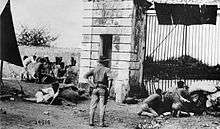 American Marines in 1915 defending the entrance gate in Cap-Haïten
American Marines in 1915 defending the entrance gate in Cap-Haïten Marine's base at Cap-Haïtien
Marine's base at Cap-Haïtien
Economy

Cap-Haïtien is known as the nation's largest center of historic monuments; it is a tourist destination. The bay, beaches and monuments have made it a resort and vacation destination for Haiti's upper classes, comparable to Pétion-Ville. Cap‑Haïtien has also attracted more international tourists, as it has been isolated from the political instability in the south of the island.
It has a wealth of French colonial architecture, which has been well preserved. During and after the Haitian Revolution, many craftsmen from Cap‑Haïtien, who were free people of color, fled to French-controlled New Orleans as they were under attack by the mostly African slaves. As a result, the two cities share many similarities in styles of architecture. Especially notable are the gingerbread houses lining the city's older streets.
Tourism
Labadie and other beaches
The walled Labadie (or Labadee) beach resort compound is located 6 miles (9.7 km) to the city's northwest. It serves as a brief stopover for Royal Caribbean International (RCI) cruise ships. Major RCI cruise ships dock weekly at Labadie. It is a private resort leased by RCI, which has generated the largest proportion of tourist revenue to Haiti since 1986. It employs 300 locals, allows another 200 to sell their wares on the premises, and pays the Haitian government US$6 per tourist.
The resort is connected to Cap‑Haïtien by a mountainous, recently paved road. RCI has built a pier at Labadie, completed in late 2009, capable of servicing the luxury-class large ships.[11] Attractions include a Haitian market, numerous beaches, watersports, a water-oriented playground, and a zip-line.[12] People not on cruises can visit the beach, too.
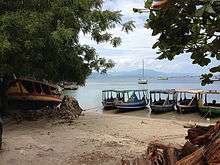
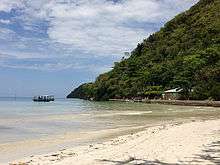
Cormier Plage is another beach on the way to Labadie, and there are also water taxis from Labadie to other beaches, like Paradis beach. In addition, Belli Beach is a small sandy cove with boats and hotels. Labadie village could be visited from here.[13]
Vertières
Vertières is the site of the Battle of Vertières, the last and defining battle of the Haitian Revolution. On November 18, 1803, the Haitian army led by Jean-Jacques Dessalines defeated a French colonial army led by the Comte de Rochambeau. The French withdrew their remaining 7,000 troops (many had died from yellow fever and other diseases), and in 1804, Dessalines' revolutionary government declared the independence of Haiti. The revolution had been underway, with some pauses, since the 1790s.
In this last battle for independence, rebel leader Capois La Mort survived all the French bullets that nearly killed him. His horse was killed under him, and his hat fell off, but he kept advancing on the French, yelling, "En avant!" (Go forward!) to his men. He has become renowned as a hero of the revolution. The 18 of November has been widely celebrated since then as a Day of Army and Victory in Haiti.
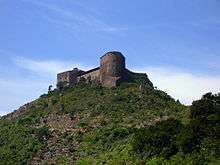

Citadelle Laferrière and Sans-Souci Palace
The Citadelle Laferrière, also known as Citadelle Henri Christophe, or the Citadelle, is a large mountaintop fortress located approximately 17 miles (27 km) south of the city of Cap‑Haïtien and 5 miles (8.0 km) beyond the town of Milot. It is the largest fortress in the Americas, and was listed by UNESCO as a World Heritage Site in 1982 along with the nearby Sans-Souci Palace. The Citadel was built by Henri Christophe, a leader during the Haitian slave rebellion and self-declared King of Northern Haiti, after the country gained its independence from France in 1804. Together with the remains of his Sans-Souci Palace, damaged in the 1842 earthquake, Citadelle Laferrière has been designated as a UNESCO World Heritage Site.[14]
Bois Caïman
Bois Caïman (Haitian Creole: Bwa Kayiman), 1.9 miles (3 km) south of road RN 1, is the place where Vodou rites were performed under a tree at the beginning of the slave revolution. For decades, maroons had been terrorizing slaveholders on the northern plains by poisoning their food and water. Makandal is the legendary (and perhaps historical) figure associated with the growing resistance movement. By the 1750s, he had organized the maroons, as well as many people enslaved on plantations, into a secret army. Makandal was murdered (or disappeared) in 1758, but the resistance movement grew.
At Bois Caïman, a maroon leader named Dutty Boukman held the first mass antislavery meeting secretly on August 14, 1791. At this meeting, a Vodou ceremony was performed, and all those present swore to die rather than to endure the continuation of slavery on the island. Following the ritual led by Boukman and a mambo named Cécile Fatiman, the insurrection started on the night of August 22–23, 1791. Boukman was killed in an ambush soon after the revolution began. Jean-François was the next leader to follow Dutty Boukman in the uprising of the slaves, the Haitian equivalent of the storming of the Bastille in the French Revolution. Slaves burned the plantations and cane fields, and massacred French colonists across the northern plains. They also attacked Cap Francais and some of the free people of color. Eventually the revolution gained the independence of Haiti from France and freedom for the slaves. The site of Dutty Boukman's ceremony is marked by a ficus tree. Adjoining it is a colonial well, which is credited with mystic powers.
Morne Rouge
Morne Rouge is 5.0 miles (8 km) to the south of Cap. It is the site of the sugar plantation known as "Habitation Le Normand de Mezy", known for several slaves who led the rebellion against the French.[15]
Natural disasters
1842 Cap-Haïtien earthquake
On 7 May 1842, an earthquake destroyed most of the city and other towns in the north of Haiti and the neighboring Dominican Republic. Among the buildings destroyed or significantly damaged was the Sans-Souci Palace. Ten thousand people died in the earthquake.[16] Its magnitude is estimated as 8.1 on the Richter scale.[17]
2010 Haiti earthquake
In the wake of the 2010 Haiti earthquake, which destroyed port facilities in Port-au-Prince, the Port international du Cap-Haïtien was used to deliver relief supplies by ship.[18]
As the city's infrastructure was little damaged, numerous businessmen and many residents have moved here from Port-au-Prince. The airport is patrolled by Chilean UN troops since the 2010 earthquake, and several hundred UN personnel have been assigned to the city as part of the ongoing United Nations Stabilization Mission in Haiti (MINUSTAH). They are working on recovery throughout the island.
After the earthquake, the port of Labadee was demolished and the pier enlarged and completely re-paved with concrete, which now allows larger cruise ships to dock, rather than tendering passengers to shore.
Transportation
Airports
Cap-Haïtien is served by the Hugo Chávez International Airport, Haiti's second busiest airport.[19] It is a hub for Salsa d'Haiti. American Airlines has recently started international flights into the enlarged airport.
Seaport
The Port international du Cap-Haïtien is Cap-Haïtien's main seaport.
Roads
The Route Nationale#1 connects Cap-Haïtien with the Haitian capital city Port-au-Prince via the cities of Saint-Marc and Gonaïves. The Route Nationale#3 also connects Cap-Haïtien with Port-au-Prince via the Central Plateau and the cities of Mirebalais and Hinche. Cap-Haïtien has one of the best grid systems in Haiti with its north-south streets were renamed as single letters (beginning with Rue A, a major avenue), and its east-west streets with numbers. The Boulevard du Cap-Haitian (also called the Boulevard Carenage) is Cap‑Haïtien's main boulevard that runs along the Atlantic Ocean in the northern part of the city.
Public transportation
Cap-Haïtien is served by tap tap and local taxis or motorcycles.
Health
Cap Haitien is served by the teaching hospital: Hôpital Universitaire Justinien.
Education
A union of four Catholic Church private schools have been present for two decades in Cap‑Haïtien. They have higher-level grades, equivalent to the lycées that feed the Écoles Normale Supérieure in France. They have high standards of academic excellence, selectivity in admissions, and generally their students come from the social and economic elite. Also, the lyceé Philippe Guerrier that was built in 1844 by the Haitian President, Philippe Guerrier, has been a fountain of knowledge for more than a century.
- Collège Notre-Dame du Perpetuel Secours des Pères de Sainte-Croix
- Collège Regina Assumpta des Sœurs de Sainte-Croix
- École des Frères de l'instruction Chrétienne
- École Saint Joseph de Cluny des Sœurs Anne-Marie Javoue
- Lyceé Philippe Guerrier built by the Haitian President, Philippe Guerrier in 1844.
Universities
Cap Haitien is home to the Cap-Haitien Faculty of Law, Economics and, Management; the Public University of the North in Cap Haitien (UPNCH). The new Université Roi Henri Christophe is nearby in Limonade.
Sport
Cap Haitien has the Parc Saint-Victor home of three major league teams: Football Inter Club Association, AS Capoise, and Real du Cap.
Communal Sections
The commune consists of three communal sections, namely:
- Bande du Nord, urban (part of the commune of Cap-Haïtien) and rural
- Haut du Cap, urban (part of the commune of Cap-Haïtien) and rural
- Petit Anse, urban (commune of Petit Anse) and rural
Notable natives
- Etienne Chavannes, painter
- Tyrone Edmond, Haitian-born model.
- Fred Joseph Jr, Haitian-born philanthropist. Founder and president of Help Us Save Us Non-Profit Organization.[20]
- Louis Mercier, Haitian educator (born May 5, 1893 in Cap-Haïtien)
- Alfred Auguste Nemours, military historian and diplomat
- Philomé Obin, artist
- Leonel Saint-Preux, footballer
- Ulrick Pierre-Louis, founder of orchestre Septentrional
Gallery
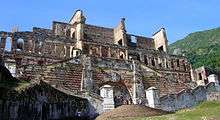 Front view of Sans-Souci Palace
Front view of Sans-Souci Palace Hotel de Ville (City Hall), site of the City Council, Cap-Haïtien.
Hotel de Ville (City Hall), site of the City Council, Cap-Haïtien.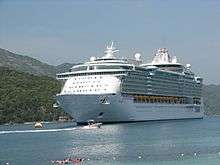 A cruise ship at Labadie.
A cruise ship at Labadie.
Television
Media
- Radyo Atlantik, 92.5 FM [24]
- Radio 4VEH (4VEF), 840 AM [25]
- Radio 4VEH, 94.7 FM [25]
- Radio 7 FM, 92.7 [26]
- Radio Cap-Haïtien
- Radio Citadelle 91.1 FM
- Radio Étincelle
- Radio Gamma, 99.7 (based in Fort-Liberté) [27]
- Radio Lumière, 98.1 FM [28]
- Radio Méga, 103.7 FM
- Radio Sans-Souci FM, 106.9
- Radio VASCO, 93.7 FM [29]
- Radio Vénus FM 104.3 FM
- Sans Souci FM, 106.9 [30]
- Voix de l'Ave Maria 98.5 FM
- Voix du Nord 90.3 FM
- Radio Intermix 93.1 FM: La Reference Radio en Haïti - www.radiointermix.com
- Radio Paradis [31]
- Radio Nirvana, 97.3 FM [32]
- Radio Hispaniola
- Radio Maxima, 98.1.FM [33]
- Radio Voix de l'ile 94.5 FM [34]
- Radio Digital 101.3 FM [35]
- Radio Oxygene 103.3 FM [36]
- Radio Passion 101.7 FM Haïti [37]
See also
Notes
- Institut Haïtien de Statistique et d'Informatique (IHSI)
- Sister Cities International Archived September 21, 2008, at the Wayback Machine
- "Portland's Sister Cities - Portland, ME". portlandmaine.gov.
- Clammer, Paul, ed. (2012). Haiti. Bradt Travel Guides. p. 177. ISBN 978-1-84162-415-0.
- Knight, Franklin W.; Liss, Peggy K. (1991). Atlantic Port Cities: Economy, Culture, and Society in the Atlantic World, 1650–1850. p. 91. ISBN 9780870496578.
- King, Stewart R. (2001). Blue Coat or Powdered Wig: Free People of Color in Pre‑revolutionary Saint Domingue. p. 23. ISBN 9780820342351.
- Kuss, Malena (2007). Music in Latin America and the Caribbean: An Encyclopedic History. p. 254. ISBN 9780292784987.
- Clammer, Paul; Grosberg, Michael; Porup, Jens (2008). Dominican Republic & Haiti. Country Guide Series. Lonely Planet. p. 331. ISBN 978-1-74104-292-4.
- Mackenzie, Charles (1830). Notes on Haiti: Made During a Residence in that Republic. 1. p. 152.
- Florida Museum of Natural History, Puerto Real.
- "Labadie". Expedia.com. Retrieved 2007-08-02.
- "Labadie". The Washington Post. 2007-01-21. Retrieved 2007-08-02.
- Cameron, p. 406
- "Citadelle Laferrière", UNESCO World Heritage Sites
- Cameron, p. 409
- Prepetit, Claude (9 October 2008), "Tremblements de terre en Haïti, mythe ou réalité ?" (PDF), Le Matin, N° 33082, quoting Moreau de Saint-Méry, Médéric Louis Élie, Description topographique, physique, civile, politique et historique de la partie française de l'Ile Saint Domingue and J. M. Jan, bishop of Cap-Haïtien (1972), Documentation religieuse, Éditions Henri Deschamps. "Archived copy". Archived from the original on 2011-12-21. Retrieved 2011-09-28.CS1 maint: archived copy as title (link)
- http://earthquakes.findthedata.org/detail/1675/Haiti-Cap-haitien
- Thompson, Ginger; Cave, Damien. "Officials Strain to Distribute Aid to Haiti as Violence Rises - NYTimes.com".
- "Haiti renames airport for Hugo Chavez". The Big Story. Archived from the original on 15 July 2015. Retrieved 6 June 2015.
- Help Us Save Us
- "Radio Tele Pardadis". www.radioteleparadis.com.
- http://www.radioteleafrica.com/
- Index of / Archived February 17, 2015, at the Wayback Machine
- "HugeDomains.com - AtLanTikHaiti.com is for sale (At Lan Tik Haiti)". www.atlantikhaiti.com.
- "Radio 4VEH - La Voix Évangélique d'Haïti". www.radio4veh.org. Archived from the original on 2008-05-15. Retrieved 2008-06-10.
- "Tele7 - Portada". www.tele7.com.
- Radio Gamma fm, 99.7 Mhz - Bienvenue Archived December 4, 2008, at the Wayback Machine
- "Radio Lumiere - Home". www.radiolumiere.org.
- "Radio Vasco". Archived from the original on 2008-05-17. Retrieved 2008-06-10.
- Sans Souci FM Archived 2008-06-19 at the Wayback Machine
- "Radio Tele Pardadis". www.radioteleparadis.com.
- "Welcome radionirvanafm.com - BlueHost.com". www.radionirvanafm.com.
- "Archived copy". Archived from the original on January 16, 2014. Retrieved January 15, 2014.CS1 maint: archived copy as title (link) CS1 maint: BOT: original-url status unknown (link)
- "Archived copy". Archived from the original on January 16, 2014. Retrieved January 15, 2014.CS1 maint: archived copy as title (link) CS1 maint: BOT: original-url status unknown (link)
- Noel, Jackendy R. "Radio Tele Digital 101.3 FM Haiti, Musique, Actualites, Interview, Infos, Foot-ball, Education, Culture". radioteledigital.fr.ht.
- "Archived copy". Archived from the original on January 25, 2014. Retrieved January 15, 2014.CS1 maint: archived copy as title (link) CS1 maint: BOT: original-url status unknown (link)
- "Radio Passion Haiti :: Sport Haiti, Actualités Haiti, Économie Haiti, Santé Haiti, Météo Haiti, Politique Haiti, Culture Haiti".
References
- Dubois, Laurent Haiti : the aftershocks of history. New York : Metropolitan Books, 2012.
- Popkin, Jeremy D. Facing racial revolution : eyewitness accounts of the Haitian Insurrection Chicago : University of Chicago Press, 2007.
- Alyssa Goldstein Sepinwall. Haitian history : new perspectives. New York : Routledge, 2012.
External links
| Wikimedia Commons has media related to Cap-Haitien. |

- short article - Columbia encyclopedia
- The Louverture Project: Cap Haïtien - Article from Haitian history wiki.
- Konbit Sante's page on Cap-Haitien. Konbit Sante is a non-denominational mixed NGO.
